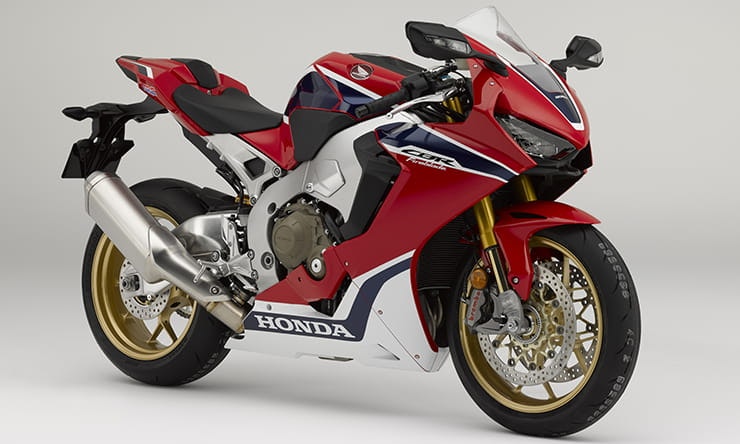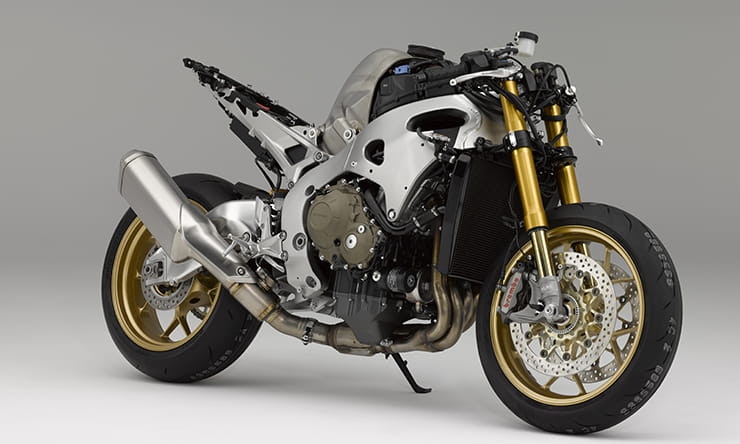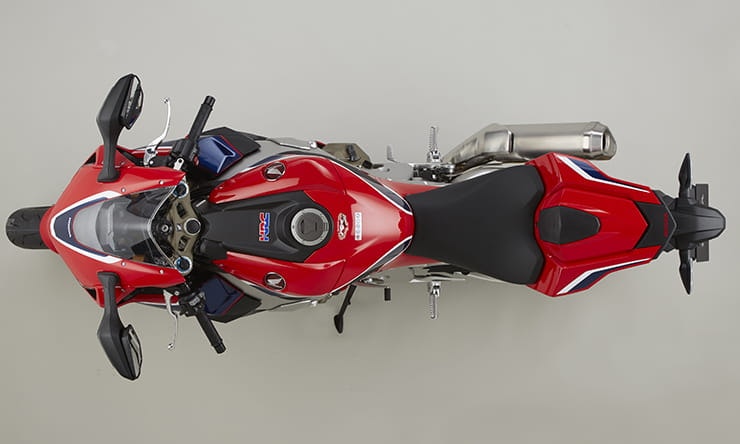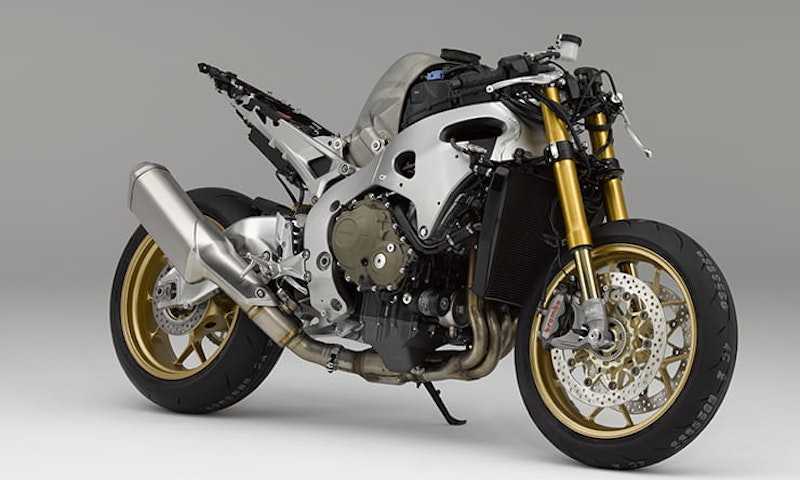Not content with launching one new Fireblade, Honda has just unveiled two all-new versions to celebrate the Fireblade’s 25th anniversary.
Meet the new 2017 Honda CBR1000RR Fireblade SP and its even more race-orientated limited-edition of 500, the CBR1000RR Fireblade SP2, making this Fireblade the first Hondas to use the SP2 moniker since the demise of the famous V-twin SP2 with which Colin Edwards won the 2002 Superbike World Championship. They are the lightest, most powerful production Fireblades ever and also the first Blade to use traction-control.
In addition to the SP and SP2, we are also expecting a standard CBR1000RR Fireblade - without the electronic suspension but with a pillion seat and pillion footrests - to be announced at next month's EICMA Show in Milan.
Although the new Fireblades may look similar to the outgoing models, Honda claim that the new bikes share just 10% of the components from their predecessors. Although there were some suggestions that this generation Fireblade would feature a V4 engine, like Honda's RCV MotoGP bikes, company bosses confirmed that the CBR and Fireblade designations stand for inline-fours, but the fact that they’ve brought the SP2 name back means that Honda is deadly serious with this latest incarnation of their 1000cc sport bike.
So not to totally confuse you, we’ll concentrate on the SP for now, and come to the hard core SP2 later.
The new SP Blade features:
Power up by 11bhp. Claimed 189bhp@12,500rpm
The lightest wet weight claim in the class at 196kg, and a massive 14kg lighter than the outgoing Blade
Cutting-edge electronics package including ride-by-wire, wheelie control, traction-control, rear wheel lift control, cornering ABS and riding modes
Ohlins semi-active suspension
Quickshift and downshift assist auto blipper
New styling with LED headlights
Single-seat unit as standard on SP
It may have taken Honda seven years to fully update the Fireblade, but on paper at least, the Big H seems to have done exactly what the world has been asking for with the Blade – more power, less weight, and a comprehensive electronics package.
Since 1992 when the original Honda CBR900RR Fireblade lit up the racetrack and transformed what a sports bike meant, Honda have been using the concept of Total Control. It means that while Blades aren’t always the most powerful bikes in the class, they do work incredibly well on road and track.
Electronics
What we do know 100% is that Honda continues the Total Control concept first started in 1992 by original Fireblade designer Tadao Baba into 2017, with what it calls ‘Next Stage Total Control’.
It means the bike gets a full electronics rider aids package to match the class-leaders like BMW’s S1000RR, Yamaha’s YZF-R1 and Ducati’s 1299S.
We saw Honda finally release a form of sports bike traction-control on the 188,000 Euro MotoGP-inspired RC213V-S last year, and that continues with the Fireblade SP.
It uses an enhanced version of the RC213V-S’ system (Honda call it Honda Selectable Torque Control), which uses rear wheel speed sensors to measure and compare front and rear wheel speed.
When the ECU detects rear wheel spin, it reduces the throttle position and power, keeping the rear wheel in line, and the front wheel on the ground for maximum traction off a corner. The Bosch inertial measurement unit also detects lean angle, acceleration, deceleration and works with the traction-control system to give the perfect amount of grip. Nine levels of adjustability are standard, and it can also be adjusted on the move.
There’s also three levels of wheelie control to make the perfect track day corner exit, or you can turn it off. A first on a Honda production motorcycle is the selectable engine brake system allowing riders to fine tune engine braking characteristics. Three modes are available.
A first for the Fireblade are riding modes which adjust levels of power, traction control and suspension settings depending on the mode. The modes are 'Fast, Fun and Safe' and can be adjusted with a switch on the left handlebar switchgear.
There’s also a quickshifter with downshift assist as fitted to the BMW S1000RR and Ducati 1299. Again, there are three settings, plus off.
As per previous Fireblades, there is cornering ABS as standard, allowing riders to brake fully hard to the apex of a corner without locking the front or rear tyre using the Brembo Monobloc radially-mounted brake set-up.
Controlling all this and sending the information back to the rider is a full-colour TFT liquid-crystal screen which uses three modes depending on the display the rider wants – 'Street, Circuit and Mechanic'. It automatically adjusts to ambient light.
It also displays lean angle, fuel consumption, average speed, time, fuel remaining once the fuel light is on, adjustable white LED shift lights, plus everything from lap time to gear position depending on the mode selected.
Engine
Compared to the existing Fireblade engine, Honda have made the new motor some 11bhp more powerful, with a claimed 189bhp at 12,500rpm, and weighs 2kg lighter. It now revs to a maximum 13,000rpm and Honda claim the bike is in a very high state of tune. Crankshaft, valve train and gearbox are all upgraded with higher-specification materials than the 2016 Blade.
The new engine is still 999.8cc with the same 76 x 55.1mm bore and stroke, but the compression ratio is up from 12.3:1 to 13:1. New pistons feature a new crown design, and new cam timing and valve lift to allow the engine to rev higher and faster than the older bike.
It features a throttle-by-wire system developed from the Honda RC213V-S, which is designed to give the rider the feeling of a cable, along with a return spring setting and the natural initial throttle play we know and love from an old-fashioned cable system, so it feels as natural as possible.
Weight has also been decreased with new engine covers made from magnesium alloy, and even the length of hoses and bolts has been reduced to lower weight. That’s some pretty extreme weight loss programme.
The battery is now 1kg lighter too, using a race style lithium iron battery, instead of an old-fashioned acid battery. There’s also a new radiator that’s 30mm narrower and 100g lighter, while delivering better heat dissipation and allowing a slimmer frontal area of the bike.
A slipper clutch stays but uses a revised set-up for a lighter feel at the lever and new aluminium cam parts instead of steel, such is Honda’s quest for weight reduction. There are also shaved down gears to save weight.
While Euro 4 might mean bigger exhausts, Honda has got round this with a titanium muffler, claimed to be 2.8kg lighter than a standard item, which has been developed in conjunction with Termignoni, the company that develops and supplies Honda’s MotoGP bike exhaust systems.
Chassis and suspension
Top-spec Ohlins semi-active suspension is fitted to the SP front and rear. It uses an Ohlins NIX30 front fork, and TTX36 rear shock.
The system is linked to the inertial measurement unit (IMU) and an electronic step motor to deliver precise control depending on throttle position, lean angle, acceleration and deceleration, adjusting damping and compression depending on the riding conditions, and the mode selected.
Riders can choose three active modes A1 (track active), A2 (sport active) and A3 (comfort active) plus manual M1 to M3 modes which can be fine tuned to the rider’s preference. The Yamaha YZF-R1 and Kawasaki ZX-10R both use non active suspension, while the BMW S1000RR is available with semi-active suspension as an option on the Sport model. The Ducati 1299S also features semi-active suspension.
In terms of the chassis itself, Honda has kept the same rake and trail at 23 degrees and 96mm but the balance of the hollow die-cast twin-spar aluminium frame and rigidity has been adjusted to improve steering response and increase feel, stability, and improve handling. An electronic steering damper also helps maintain stability.
The frame uses thinner walls to save 500g, and it’s 10 per cent more flexible in the torsional plane to give a faster reacting chassis. There’s less forward and back yaw under acceleration and braking. At the rear, an 800g lighter subframe improves handling, along with a new aluminium swingarm. Wheelbase is 1404mm and the seat height is 831mm, lower than the R1’s 855mm seat height, and a few mm off the ZX-10R at 835mm.
Styling
Line the two bikes up next to each other and you can see the bike’s new stripped-back and MotoGP inspired styling.
LED lights are front and rear and the bike is some 24mm narrower at the upper fairing, yet still allowing the rider to get out of the wind, claim Honda. It’s 18mm narrower at the middle of the fairing, and 15mm narrower at the rider’s knees.
Key to the lightness of the bike is its new (and first for a production bike) titanium fuel tank which holds 16 litres and weighs 1.3kg lighter than the previous model. It improves mass centralisation of the bike and improves handling, too.
Lighter Y-shape aluminium wheels are also fitted with 120/70 x 17 front and 190/50 x 17 rear tyres.
The CBR1000RR SP will be available early next year in a red-based Honda tricolour colour scheme. No prices are yet available.
HONDA FIREBLADE SP vs RIVALS:
2017 Honda Fireblade SP – 189bhp@12,500rpm. 196kg wet weight claimed
2016 Yamaha R1 – 197.3bhp@13,500rpm (186bhp actual). Wet weight 199kg
2016 Kawasaki ZX-10R – 197.3bhp claimed (193.4bhp actual). Wet weight 206kg
2016 BMW S1000RR – 199bhp @13,500rpm claimed (194.2bhp actual). Wet weight 204kg
Honda CBR1000RR Fireblade SP2 – the baddest, maddest Fireblade ever built
Not content to launch one Fireblade to celebrate 25 years of the legendary Honda, meet the new Honda Fireblade SP2 – the maddest, baddest road-going production Honda Fireblade race replica ever built.
Just 500 of the new limited-edition Honda CBR1000RR Fireblade SP2s will be built and they have the potential to turn the bike into a full-on world superbike with two HRC race kits available. Like the CBR1000RR SP, the SP2 version makes a claimed 189bhp and 89ft-lb of torque, but weighs in a claimed 1kg lighter than the SP at 195kg.
Designed as a homologation-special superbike racer for the road the new CBR1000RR Fireblade SP2 features:
Revised cylinder head, valves combustion chambers and pistons
Launch control, pit lane speed limiter and five-level power modes
Lightweight gold-coloured Marchesini wheels
Carbon inserts and gold striping
HRC sport and HRC full race kits available at extra cost
But for a moment, forget the fact that it makes the same power as the SP, this is a full-on limited edition Fireblade race bike for the road, designed as a platform for racing, a real competitor for Yamaha’s YZF-R1M, and likely to be almost as rare on the road as the ultra-exclusive RC213V-S.
The lightweight Marchesini wheels reduce inertia by 18% at the front and 9% at the rear, the bodywork is marked out on the SP2 by carbon pattern inserts interwoven into the Tricolour paint scheme, but it’s the potential in the engine that makes it so interesting.
The 76mm bore is identical to the SP, but the SP2 features 1mm larger diameter intake and 1.5mm larger exhaust valves, new valve shapes and new combustion chambers to make it breathe better. Think Fireblade SP but blueprinted, in theory.
It also has elongated spark plugs and a water jacket wrapped round the combustion chambers to improve cooling – a technology taken from Honda’s RC213V MotoGP bike.
The pistons are heat treated with a new design, there’s shorter piston rings, lighter piston pins, and it’s ready to house high-lift camshafts. As well as the SP’s full electronics, the SP2 gets five-stage power modes (three on the SP), a programmable 6000rpm to12,000rpm launch control, and a pit-lane speed limiter.
HRC will also make a full race kit available with more than 80 parts from a race ECU to titanium exhaust, cylinders, stripped-down wiring harness and engine internals. Expect to see this as the basis for the factory World Superbike and British Superbikes.
A lower-spec SP2 Sport kit will also be available and includes HRC cams, valve springs, race ECU and full exhaust system.
The SP2 will be campaigned in HRC Race kit trim by Nicky Hayden and MotoGP refugee Stefan Bradl as Honda attempt to put themselves back on top of World Superbikes, a title they haven’t won since 2007 with retired racer James Toseland at the helm.
But it’s not just World Superbikes that will benefit from the new 'Blade. Despite being a relatively old design, the current Fireblade has had some race success in British Superbikes so far this year, with Jason O’Halloran winning at Snetterton. Honda also got two out its three riders through to the BSB showdown with O’Halloran and Dan Linfoot.
A new Honda CBR1000RR Fireblade SP2 backed by the might of the Honda factory and the Lincolnshire-based Honda Racing team is only likely to bolster that BSB success further. TT Legend John McGuinness will also be looking to bolster his Isle of Man TT wins next year with the new Fireblade SP2, too.
The Fireblade is the most successful 1000cc machine ever at the TT already, with 23 wins to the bike’s name but following last year’s Superbike and Senior TT races, McGuinness said he was happy with his riding considering how old the bike was. A new bike will surely put McGuinness back at the front and enable him to increase his own tally of 23 TT wins.
We hear the SP2 version of the bike in race trim has already been developed on European tracks for the last year, such is Honda’s hunger for race success in 2017.
Share on social media:



